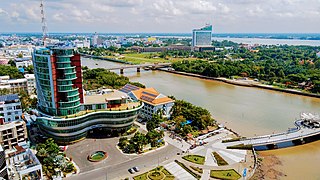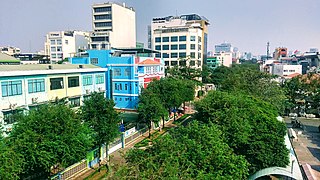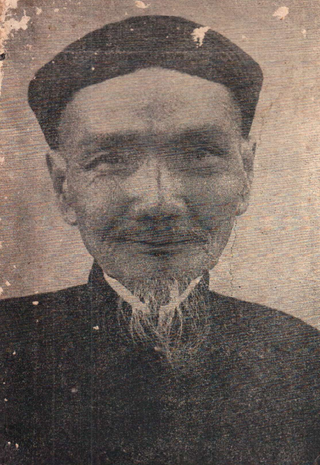The following is a list of Lakes in Vietnam.

On the first tier, Vietnam is divided into fifty-eight provinces and five municipalities under the command of the central government. Municipalities are the highest-ranked cities in Vietnam. Municipalities are centrally-controlled cities and have special status equal to the provinces.
Articles related to Vietnam and Vietnamese culture include:

Cần Thơ, also written as Can Tho or Cantho, is the fourth-largest city in Vietnam, and the largest city along the Mekong Delta region in Vietnam.

Tây Ninh is a provincial city in Southeastern Vietnam. It is the capital of Tây Ninh Province, which encompasses the town and much of the surrounding farmland. Tay Ninh is one of nine provinces and cities in the Southern Key Economic Region. Tây Ninh is approximately 90 km northwest of Ho Chi Minh City, Vietnamese largest city and 182 km to Phnom Penh, capital of Cambodia. As of 2019, the city had a population of 135,254 over the provincial population of 1,169,165, and a total area of 140 km2 (54 sq mi).

Lệ Thủy is a district of Quảng Bình province in the North Central Coast of Vietnam. The district borders Quảng Ninh district on the north, Vĩnh Linh district on the south, Laos on the west. Lệ Thủy central is 40 km south of the provincial capital Đồng Hới. The district government seat is Kiến Giang Township. The district area is 1420.52 km2, population: 140,804 (1998). Lệ Thủy district is home to Võ Nguyên Giáp and the family of Ngô Đình Diệm. Economy bases on agriculture, mainly rice culture. Mỹ Trạch massacre by French army happened here on 29 November 1947.

National Route 1, also known as National Route 1A, is the trans-Vietnam highway. The route begins at km 0 at Hữu Nghị Quan Border Gate near the China-Vietnam border, runs the length of the country connecting major cities including Hanoi, Da Nang and Ho Chi Minh City, and ends at km 2301.34 at Năm Căn township in Cà Mau Province.

The Metropolitan Archdiocese of Saigon or Archdiocesse of Ho Chi Minh City is a Roman Catholic ecclesiastical territory in the south of Vietnam. By far the largest diocese in the country by population of people and second in the number of Catholics, yet like most big cities it only covers a small area of 2,390 km2 (920 sq mi).

Tourism in Vietnam is a component of the modern Vietnamese economy. In 2019, Vietnam received 18 million international arrivals, up from 2.1 million in the year 2000. The Vietnam National Administration of Tourism is following a long-term plan to diversify the tourism industry, which brings foreign exchange into the country.

District 3 is an urban district of Ho Chi Minh City, the largest city in Vietnam. Together with District 1, District 3 is considered the bustling heart of the city, with a multitude of businesses, religious sites, historical buildings and tourist attractions.

Vĩnh Thuận is a rural district of Kiên Giang province in the Mekong River Delta region of Vietnam. As of 2003 the district had a population of 133,539. The district covers an area of 608 km². The district capital lies at Vĩnh Thuận.
Phú Mỹ is a district-level town of Bà Rịa–Vũng Tàu province, Vietnam.

Đăng đàn cung was the royal anthem of the Nguyễn dynasty, Vietnam.

Mẫu Thượng Thiên or Mẫu Đệ Nhất (母第一) is one of the four heavenly mothers in the Four Palaces in Vietnamese folk religion. She is one of the spirits invoked in the form of lên đồng mediumship particularly associated with Đạo Mẫu worship.

Vietnamese folk religion is a group of spiritual beliefs and practices adhered by the Vietnamese people. About 86% of the population in Vietnam are reported irreligious, but are associated with this tradition.

Phạm Đan Trường is a Vietnamese male singer and actor. He is known for pop, dance and folk songs.

Hồ Văn Trung was a Vietnamese writer.
Phú Thuận may refer to several commune-level subdivisions in Vietnam, including